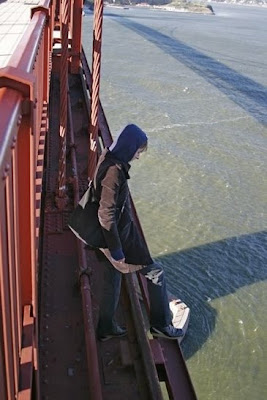The Bridge begins with an extended montage of scenic views of San Francisco's beautiful Golden Gate bridge and the people who enjoy it. Driving over, walking over, sailing under or just enjoying the view. But then one of these 'scenic views' captures someone ending their life. And one of the many people walking across stops, gets over the railing and jumps. After that, it's compelling to watch and listen very intently, horrified by what might happen, while listening to the possible reasons that these people ended it all.
Certainly not a subject for everyone to want to watch, but an insightful, fascinating, carefully structured and tense documentary.

Director Eric Steel filmed the bridge for a year, shooting with long lenses from up to a mile away. He, like the bridge authorities, were on the lookout for potential suicides, preventing them whenever there was enough time. But as you see in the film, it can only take a few seconds to get over the barrier and over the edge.
The film recounts stories from the two dozen fatal leaps that happened over the year. It struggles with the reasons that people pick the bridge, especially when the 25-storey drop into the water isn't a surefire or painless way to die. One of the 'jumpers' even survives. His interview providing insight into what makes anyone contemplate and attempt what should have been suicide.

Families, friends and passers-by can only guess what finally pushed these souls to climb over the edge, describing how there can be few warning signs from even the most desperate. But with each new story, you never know which of the many possible outcomes it'll lead to.
Afterwards, I remembered one of the most famous San Francisco movies, Hitchcock's Vertigo (1958), had a suicide scene by the bridge. But that was a thriller, a dark fantasy. I'd never considered this wonder of the modern world to be a real suicide spot.

While the startling footage of actual suicides is the kind of mondo video clip that's specifically hunted down online, this film is very different because it provides so much context. Backstory, aftermath and implication. This is all provided from interviews, and not dictated through captions or voiceovers.
The Bridge is a valuable and astonishing film for talking at length about suicide and the widespread problem of serious mental illness.
The original 2003 New Yorker article 'Jumpers' is here.



















































